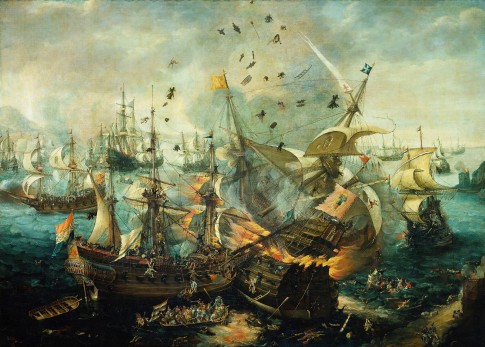The Explosion of the Spanish Flagship in the Battle of Gibraltar April 25th 1607 by Cornelis Claesz van Wieringen, ca 1622
Rijksmuseum Amsterdam
(image 1600 x 1145 pixels 1.6 MB)
In 1621 the Admiralty of Amsterdam decided to commission a painting commemorating the Battle of Gibraltar that took place in 1607. This battle, in which the Dutch squadron had destroyed the Spanish fleet in the Bay of Gibraltar, was the first major Dutch naval victory in the Eighty Years’ War. This battle had cost the Dutch fleet commander Admiral Jacob van Heemskerk his life. This man was famous for his exploits in searching for the North-East Passage to India and his wintering in Novaya Zemlya in 1596-1597 together with another famous explorer Willem Barents.
This painting depicts an episode of that battle. It is not signed and until 1983 had been attributed to Hendrick Vroom.
In 1621 the head of the Admiralty of Amsterdam Prince Maurice (Mauritz) decided to get a new painting for his newly built residence in the Stadtholder Quarter in The Hague. Initially Hendrick Vroom was contracted to make a draft. Vroom requested an astronomical sum of 6000 florins. The negotiations stalled, and, after Vroom left the meeting, “calling out words of insolence”, it was concluded that the task should also be given to “another good Master in this Art, so that one could decide, who of the two is better and whom the contract is to be awarded”. Two officials travelled to Haarlem and visited there the studios of both Vroom and van Wieringen. The works of the latter made a very good impression and he was asked to make a draft picture “of two ships, eight foot wide and five foot high”.
This story is most likely about a painting in the Rijksmuseum in Amsterdam that depicts the explosion of a Spanish ship in the Battle of Gibraltar on April 25th 1607, even though its dimensions are not exactly the same. The draft picture had been painted in just one month after the task was given, which must have been between July and August 1621. If it was the draft van Wieringen created to get the contract, he must have been working especially fast probably to impress the Admiralty’s officials with his skills.
The central part of the painting is occupied by two ships, a Dutch warship ramming a Spanish two-decker. The stern of the latter is being consumed by an infernal explosion that is shredding its upper structure, masts, rigging and sails. The tafferel of the exploding ship hosts a carved figure of a bishop and above it flies a banner with an angel with a divine halo around it. One of the ship’s crew members raises his arms to the angel praying for saving his life from the imminent death. His less lucky mates are already in the air thrown up by the mighty force of the blast. This terrifying scene gives the painting a dramatic character. It is impossible to tell exactly the names of these two ships, although it is known that several of the Spanish ships had exploded that day.
